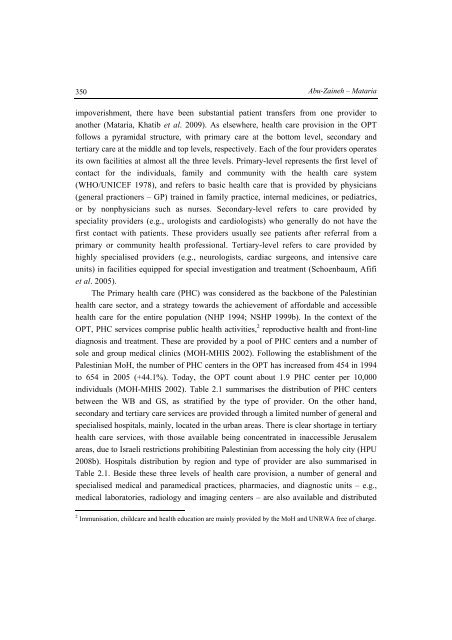The Palestinian Economy. Theoretical and Practical Challenges
The Palestinian Economy. Theoretical and Practical Challenges
The Palestinian Economy. Theoretical and Practical Challenges
You also want an ePaper? Increase the reach of your titles
YUMPU automatically turns print PDFs into web optimized ePapers that Google loves.
350<br />
Abu-Zaineh – Mataria<br />
impoverishment, there have been substantial patient transfers from one provider to<br />
another (Mataria, Khatib et al. 2009). As elsewhere, health care provision in the OPT<br />
follows a pyramidal structure, with primary care at the bottom level, secondary <strong>and</strong><br />
tertiary care at the middle <strong>and</strong> top levels, respectively. Each of the four providers operates<br />
its own facilities at almost all the three levels. Primary-level represents the first level of<br />
contact for the individuals, family <strong>and</strong> community with the health care system<br />
(WHO/UNICEF 1978), <strong>and</strong> refers to basic health care that is provided by physicians<br />
(general practioners – GP) trained in family practice, internal medicines, or pediatrics,<br />
or by nonphysicians such as nurses. Secondary-level refers to care provided by<br />
speciality providers (e.g., urologists <strong>and</strong> cardiologists) who generally do not have the<br />
first contact with patients. <strong>The</strong>se providers usually see patients after referral from a<br />
primary or community health professional. Tertiary-level refers to care provided by<br />
highly specialised providers (e.g., neurologists, cardiac surgeons, <strong>and</strong> intensive care<br />
units) in facilities equipped for special investigation <strong>and</strong> treatment (Schoenbaum, Afifi<br />
et al. 2005).<br />
<strong>The</strong> Primary health care (PHC) was considered as the backbone of the <strong>Palestinian</strong><br />
health care sector, <strong>and</strong> a strategy towards the achievement of affordable <strong>and</strong> accessible<br />
health care for the entire population (NHP 1994; NSHP 1999b). In the context of the<br />
OPT, PHC services comprise public health activities, 2 reproductive health <strong>and</strong> front-line<br />
diagnosis <strong>and</strong> treatment. <strong>The</strong>se are provided by a pool of PHC centers <strong>and</strong> a number of<br />
sole <strong>and</strong> group medical clinics (MOH-MHIS 2002). Following the establishment of the<br />
<strong>Palestinian</strong> MoH, the number of PHC centers in the OPT has increased from 454 in 1994<br />
to 654 in 2005 (+44.1%). Today, the OPT count about 1.9 PHC center per 10,000<br />
individuals (MOH-MHIS 2002). Table 2.1 summarises the distribution of PHC centers<br />
between the WB <strong>and</strong> GS, as stratified by the type of provider. On the other h<strong>and</strong>,<br />
secondary <strong>and</strong> tertiary care services are provided through a limited number of general <strong>and</strong><br />
specialised hospitals, mainly, located in the urban areas. <strong>The</strong>re is clear shortage in tertiary<br />
health care services, with those available being concentrated in inaccessible Jerusalem<br />
areas, due to Israeli restrictions prohibiting <strong>Palestinian</strong> from accessing the holy city (HPU<br />
2008b). Hospitals distribution by region <strong>and</strong> type of provider are also summarised in<br />
Table 2.1. Beside these three levels of health care provision, a number of general <strong>and</strong><br />
specialised medical <strong>and</strong> paramedical practices, pharmacies, <strong>and</strong> diagnostic units – e.g.,<br />
medical laboratories, radiology <strong>and</strong> imaging centers – are also available <strong>and</strong> distributed<br />
2 Immunisation, childcare <strong>and</strong> health education are mainly provided by the MoH <strong>and</strong> UNRWA free of charge.
















